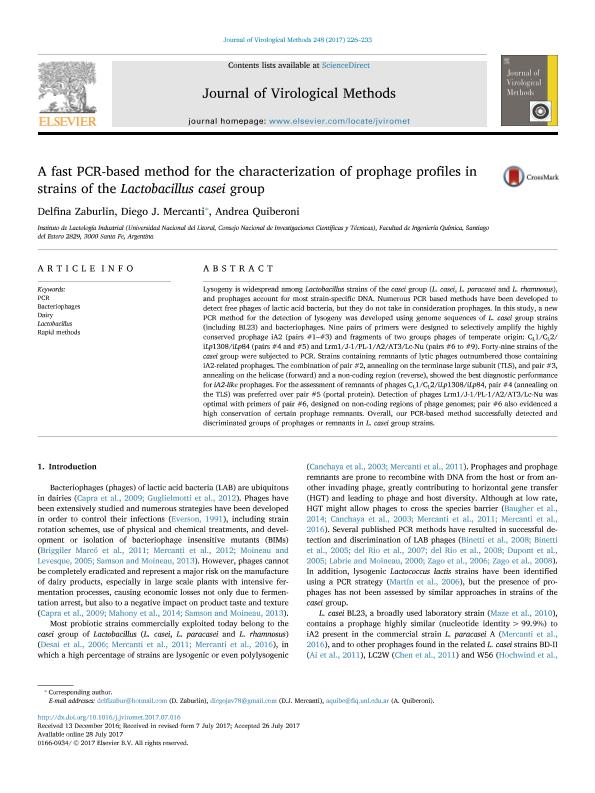Mostrar el registro sencillo del ítem
dc.contributor.author
Zaburlin, Delfina
dc.contributor.author
Mercanti, Diego Javier

dc.contributor.author
Quiberoni, Andrea del Lujan

dc.date.available
2020-07-26T13:59:09Z
dc.date.issued
2017-07
dc.identifier.citation
Zaburlin, Delfina; Mercanti, Diego Javier; Quiberoni, Andrea del Lujan; A fast PCR-based method for the characterization of prophage profiles in strains of the Lactobacillus casei group; Elsevier Science; Journal of Virological Methods; 248; 7-2017; 226-233
dc.identifier.issn
0166-0934
dc.identifier.uri
http://hdl.handle.net/11336/110272
dc.description.abstract
Lysogeny is widespread among Lactobacillus strains of the casei group (L. casei, L. paracasei and L. rhamnosus), and prophages account for most strain specific DNA. Numerous PCR based methods have been developed to detect free phages of lactic acid bacteria, but they do not take in consideration prophages. In this study, a new PCR method for the detection of lysogeny was developed using genome sequences of L. casei group strains (including BL23) and bacteriophages. Nine pairs of primers were designed to selectively amplify the highly conserved prophage iA2 (pairs #1 to #3) and fragments of two groups phages of temperate origin: CL1/CL2/iLp1308/iLp84 (pairs #4 and #5) and Lrm1/J-1/PL-1/A2/AT3/Lc-Nu (pairs #6 to #9). Forty nine strains of the casei group were subjected to PCR. Strains containing remnants of lytic phages outnumbered those containing iA2 related prophages. The combination of pair #2, annealing on the terminase large subunit (TLS), and pair #3, annealing on the helicase (forward) and a non-codingregion (reverse), showed the best diagnostic performance for iA2-like prophages. For the assessment of remnants of phages CL1/CL2/iLp1308/iLp84, pair #4 (annealing on the TLS) was preferred over pair #5 (portal protein). Detectionof phages Lrm1/J-1/PL-1/A2/AT3/Lc-Nu was optimal with primers of pair #6, designed on non coding regions of phage genomes; pair #6 also evidenced a high conservation of certain prophage remnants. Overall, our PCR based methodsuccessfully detected and discriminated groups of prophages or remnants in L. casei group strains.
dc.format
application/pdf
dc.language.iso
eng
dc.publisher
Elsevier Science

dc.rights
info:eu-repo/semantics/openAccess
dc.rights.uri
https://creativecommons.org/licenses/by-nc-sa/2.5/ar/
dc.subject
PCR
dc.subject
BACTERIOPHAGES
dc.subject
DAIRY
dc.subject
LACTOBACILLUS
dc.subject.classification
Alimentos y Bebidas

dc.subject.classification
Otras Ingenierías y Tecnologías

dc.subject.classification
INGENIERÍAS Y TECNOLOGÍAS

dc.title
A fast PCR-based method for the characterization of prophage profiles in strains of the Lactobacillus casei group
dc.type
info:eu-repo/semantics/article
dc.type
info:ar-repo/semantics/artículo
dc.type
info:eu-repo/semantics/publishedVersion
dc.date.updated
2020-07-20T16:18:14Z
dc.journal.number
248
dc.journal.pagination
226-233
dc.journal.pais
Países Bajos

dc.journal.ciudad
Amsterdam
dc.description.fil
Fil: Zaburlin, Delfina. Consejo Nacional de Investigaciones Científicas y Técnicas. Centro Científico Tecnológico Conicet - Santa Fe. Instituto de Lactología Industrial. Universidad Nacional del Litoral. Facultad de Ingeniería Química. Instituto de Lactología Industrial; Argentina
dc.description.fil
Fil: Mercanti, Diego Javier. Consejo Nacional de Investigaciones Científicas y Técnicas. Centro Científico Tecnológico Conicet - Santa Fe. Instituto de Lactología Industrial. Universidad Nacional del Litoral. Facultad de Ingeniería Química. Instituto de Lactología Industrial; Argentina
dc.description.fil
Fil: Quiberoni, Andrea del Lujan. Consejo Nacional de Investigaciones Científicas y Técnicas. Centro Científico Tecnológico Conicet - Santa Fe. Instituto de Lactología Industrial. Universidad Nacional del Litoral. Facultad de Ingeniería Química. Instituto de Lactología Industrial; Argentina
dc.journal.title
Journal of Virological Methods

dc.relation.alternativeid
info:eu-repo/semantics/altIdentifier/url/https://www.journals.elsevier.com/journal-of-virological-methods
dc.relation.alternativeid
info:eu-repo/semantics/altIdentifier/doi/http://dx.doi.org/10.1016/j.jviromet.2017.07.016
Archivos asociados
